- Home
Welcome to Saddleworld!
The Saddleworld Website is a showcase
of a selected range of products that are available from any Saddleworld throughout Australia.If you would like to purchase a specific product, please contact your nearest store.
Click on Our Stores to find your nearest Saddleworld Store!
- Brands
- Products
Saddleworld Products & Brands
Saddles
Bridlewear
Tack Room
Horse Boots
- Kentucky »
- Eurohunter »
- Eurohunter »
Helmets
- Our Stores
Choose your nearest store
New South Wales
Queensland
South Australia
- Evandale »
- Gawler »
- Mt Barker »
- Mt Gambier »
- Wangara »
- Devonport »
- Launceston »
Western Australia
Tasmania
- News & Tips
- Catalogues
2017 Saddleworld Product Guide Out Now!

The 2017 Saddleworld Product Guide is out now.
Visit your nearest Saddleworld store and pick up your FREE copy today.
View the 2017 Product Guide Online Now!- About Us

Equivac® Vaccines – The best form of Equine Insurance!
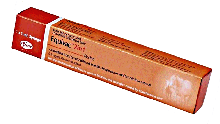
Most horse owners have heard of Tetanus and Strangles as these health issues pose a real threat to the life of a horse.
Tetanus causes signs of muscle stiffness, tremors and "lockjaw". Treatment is difficult, time consuming, very expensive and often unsuccessful. Strangles is the most significant infectious disease affecting horses. It is caused by a bacterium, Streptococcus equi, which is highly contagious and horses kept in close proximity to other horses with frequent stock movement on the property, are highly susceptible.
In both cases, the risks are high and treatment can be very expensive and treatmen is often unsuccessful with heartbreaking consequences and only huge vet bills remaining. Fortunately, the solution is simple and peace of mind assured by the administration of an EQUIVAC 2 in 1 vaccine annually.
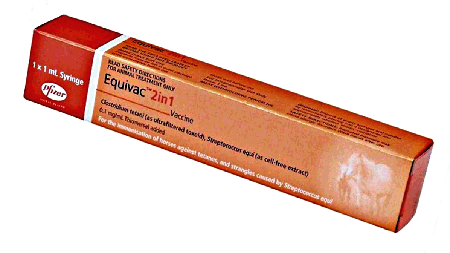
Here are some facts …
TETANUS:
EPIDEMIOLOGY: Persistent spores can be found in the soil (it is more prevalent in cultivated than uncultivated soils) and organisms are routinely isolated from the faeces of many domestic animals, including the dog and cat, and also from humans.
CAUSE: Tetanus occurs when a wound becomes infected with bacterial spores of Clostridium tetani. These spores germinate, multiply and produce a very powerful poison, which affects the muscles. Some cases of tetanus occur from wounds that are so small they are not noticed.
SYMPTOMS: An affected horse moves with a stiff-legged gait, often with the tail held out stiffly and the ears pricked. As the disease progresses the muscles become so rigid and stiff that the horse may fall and not be able to get up again. Convulsions may occur and death is caused by paralysis of the breathing muscles.
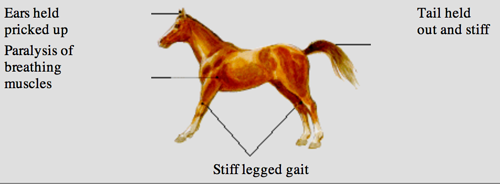
IMMUNITY: Animals that have recovered from natural infection are not immune and still require vaccination for protection.TREATMENT: Treatment is difficult, time consuming, very expensive and often unsuccessful. It involves the use of tetanus antitoxin (EQUIVAC TAT) to neutralise unbound circulating toxin, penicillin to prevent further growth of C/. tetani, muscle relaxants to relax the rigid muscles, and supportive therapy until the toxin is eliminated or destroyed.
CONTROL: Vaccination is the only way to provide safe, effective long-term protection against tetanus. If an unvaccinated horse is injured, tetanus antitoxin should be administered to provide immediate but short-term (3 weeks) protection. At the same time a vaccination program should be commenced to develop long-lasting immunity. The tetanus vaccine EQUIVAC T may be administered intramuscularly on one side of the neck, while the tetanus antitoxin is injected subcutaneously on the other side of the neck. A separate syringe and needle should be used for each product. This will result in both immediate and long lasting protection.
Tetanus vaccine alone provides long-lasting protection but immunity takes 7-10 days to develop, and an injured horse may develop tetanus before protection is achieved. Tetanus antitoxin alone provides protection in 2-3 hours but it only lasts for 3 weeks and tetanus may develop after this protection has waned. Therefore, simultaneous injection of 1500 units of EQUIVAC - TAT and 1mL of EQUIVAC - T provides optimal immediate and long-term protection. These injections should be given on different sides of the neck. Another dose of EQUIVAC -T four weeks later is required for long-lasting protection.
EQUIVAC 2 IN 1 is the simple reassuring solution – protect your horses - Prevention is better than cure.
SOME QUESTIONS AND ANSWERS ABOUT EQUIVAC TETANUS VACCINES
WHY VACCINATE?
Vaccination is the only way to provide long-term protection against tetanus. It should be remembered that the horse is the most susceptible animal to tetanus.WHAT ABOUT THE USE OF TENATUS ANTITOXIN?
Tetanus antitoxin provides immediate protection but this protection only lasts for 3 weeks. Horses given tetanus antitoxin can develop tetanus once the levels of antitoxin have dropped below the protective level. It is extremely risky if owners are relying on the use of tetanus antitoxin given to horses, after a wound, to protect them against tetanus, as some cases of tetanus occur from wounds, which are so small, they are not noticed.DOES THE VACCINATION CAUSE A REACTION?
Like a number of other vaccines, EQUIVAC-T or EQUIVAC-2 in 1 can cause a local swelling at the site of the injection. Provided the injection has been carried out aseptically, any swelling should resolve spontaneously.HOW IS THE VACCINE ADMINISTERED?
The vaccine is injected intramuscularly. The most convenient site for injection is the centre of the side of the neck.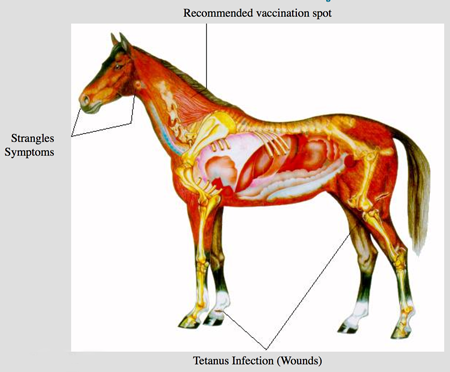
WHAT IS THE VACCINATION SCHEDULE?
For all horses and foals, three months of age and above, the primary vaccination course consists of two injections of EQUIVAC-T or EQUIVAC-2 in 1, four weeks apart, followed up by a booster dose one year later. Boosters after this are recommended every five years. (see vaccination chart below)WHAT DO WE GIVE AN UN-VACCINATED HORSE WITH A WOUND?
In these cases administer 1500 units (1 syringe) of EQUIVAC-TAT on one side of the neck and 1 mL (1 syringe) of EQUIVAC-T on the other side of the neck. This regime provides immediate and lasting protection. The dose of EQUIVAC-T should be repeated four weeks later.
(Antitoxin alone has limited usefulness owing to the shortness of its protective action and a single dose of Tetanus Vaccine given to an unimmunised horse at the time of wounding or surgery may not prevent tetanus. This is why the simultaneous injection of EQUIVAC-TAT and EQUIVAC-T is recommended. Provided that only 1500 units of EQUIVAC-TAT is given, there will be no interference with the development of active immunity.)EQUINE TETANUS/STRANGLES – Eliminate the Risk witha specific EQUIVAC vaccine OR EQUIVAC 2 in 1- available at SADDLEWORLD

STRANGLES:
WHAT ARE THE SIGNS OF STRANGLES?
Typically, horses suffering from strangles have pus discharging from the nostrils and swellings (abscesses) forming in the lymph nodes (glands) under the jaw. Most animals recover, but horses that contract even a mild case of strangles must be isolated and removed from training or heavy work for up to 3 months! In some cases the infection can cause chronic illness or even death.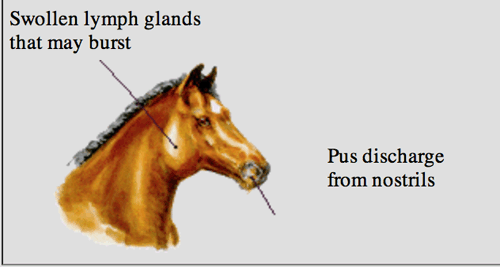
EPIDEMIOLOGY: Strangles is very contagious, especially with foals, spreading easily from horse to horse and often leading to large outbreaks with many horses affected. It is spread in the discharges (pus) from the nose and burst abscesses. Objects such as water troughs, feed buckets, brushes, reins and other equipment, if contaminated with infected pus, can also spread the disease. Recovered horses can spread the disease for up to eight months, even though they can appear clinically healthy and normal.
CAUSE: Strangles is the most important infectious disease affecting horses. It is caused by a bacterium, Streptococcus equi.
SIGNS: Typically, horses suffering from strangles have pus discharging from the nostrils and swellings (abscesses) forming in the lymph glands under the jaw. These abscesses often burst and exude a thick yellow pus. Affected horses can have fever, be depressed and may stop eating. Most animals recover, but horses that contract even a mild case of strangles must be isolated and removed from training or heavy work for up to 3 months. In some cases the infection can cause chronic illness or even death.
IMMUNITY: In common with other respiratory diseases, such as canine cough and feline respiratory disease, immunity is short lived and incomplete. In fact 25% of horses infected with strangles do not appear to develop immunity. This makes it very difficult for a vaccine to provide complete protection and it is not claimed that the vaccine is an absolute preventative. However, field experience has shown that vaccination can control the disease by reducing the degree of clinical disease and reducing the number of horses affected.
TREATMENT: Penicillin is the antibiotic of choice against S.equi. Abscesses may need to be opened and drained and good supportive care is vital for recovery.
CONTROL: It is strongly recommended that all horses be included in a regular program of vaccination. It is particularly important that booster doses be given prior to periods of greater risk of infection, such as the breeding or performance season. Pregnant mares may be vaccinated up to two weeks before foaling.
Consideration should be given to vaccinating high-risk horses (eg. brood mares, stallions, performance, pony club, racing and eventing horses) every six months. In the event of an outbreak of strangles, horses should be segregated into three groups and handled as follows:
(a) Those affected by the disease should be treated, but not vaccinated
(b) Horses with no known contact with the disease should be vaccinated immediately
(c) Horses known to have been in contact should be observed for seven to ten days and vaccinated only if they have a normal temperature and show no clinical signs of the disease.EQUIVAC 2 IN 1 is the simple reassuring solution – protect your horses ... Prevention is better than cure.
SOME QUESTIONS AND ANSWERS ABOUT EQUIVAC
WHY VACCINATE?
Vaccination provides the best possible protection against strangles, which is the most important infectious disease problem for horses.DOES VACCINE PROVIDE 100% PROTECTION?
Field experience suggests that a full and regular program of vaccination for all horses will usually control or very markedly reduce the incidence and severity of strangles. However it is not claimed that the vaccine is an absolute preventative. Vaccination will reduce the spread in an outbreak with fewer horses affected by strangles and those that do show signs have a milder disease with shorter recovery and possible protection against spread through the body.
Thus, vaccination has good benefits and is the best protection possible. It should be pointed out that there are other diseases, caused by different organisms, which may be confused with strangles.CAN THE VACCINE BE USED IN AN OUTBREAK?
Yes. In the event of an outbreak of strangles, horses should be segregated into three groups, those affected by the disease should be treated, but not vaccinated. Horses with no known contact with the disease should be vaccinated immediately. Horses known to have been in contact should be observed for seven to ten days and vaccinated only if they have a normal temperature and show no clinical signs of the disease.DOES EQUIVAC CAUSE A REACTION?
Like a number of other vaccines, EQUIVAC S OR EQUIVAC 2 IN 1 can cause some local swelling at the site of the injection, especially if injected subcutaneously and not intramuscularly. Provided the injection has been carried out aseptically, any swelling should disappear in a few days.WHAT IS THE VACCINATION SCHEDULE?
When horses and foals are vaccinated against strangles for the first time, they require a primary vaccination course consisting of three doses of EQUIVAC S OR EQUIVAC 2 IN 1. The three doses are given with an interval of two weeks between injections. Booster doses should be given at least annually and six-monthly revaccination should be considered in circumstances where the risk of infection is known to be high.
HOW IS THE VACCINE ADMINISTERED?
The vaccine is injected intramuscularly. The most convenient site for injection is the centre of the side of the neck. The needle can be attached to the syringe and then administered to the horse. Alternatively, the needle may be inserted into the muscle and then the syringe attached and the vaccine injected.BE SURE TO ELIMATE THE RISK OF TETANUS AND STRANGLES AND PROTECT YOUR HORSE BY PICKING UP EQUIVAC 2 in 1 FROM YOU LOCAL SADDLEWORLD STORE.
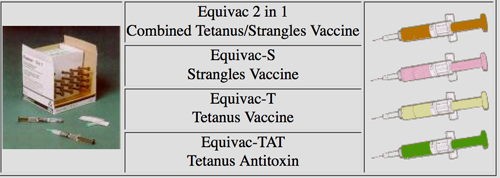
BE SURE TO MARK THE CALENDAR AND REPEAT YOUR HORSE INSURANCE POLICY EVERY 12 MONTHS.












 Brands
Brands
Ammo
Eurohunter Rugs
Grazioli Boots
Kentucky Horseware
PDS Carl Hester Collection
Pessoa Saddles
Prestige Saddles
Thorowgood
Trainer’s
Sponsored Events
Saddleworld Melbourne International 3DE
Saddleworld Australian Youth Showjumping Championships
Saddleworld Brisbane CDI
PSI Dressage & Jumping with the Stars
Copyright © 2013 Saddleworld Pty Ltd.
Taking care of all your horse needs. Saddles, horse rugs, riding equipment, bridles, saddlery, clothing, veterinary supplies. All Rights Reserved.
Home | Privacy Policy | Pricing Policy | Contacts | Join - Products



